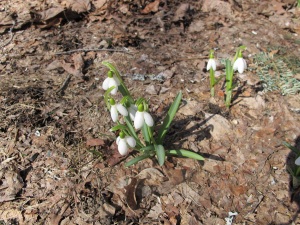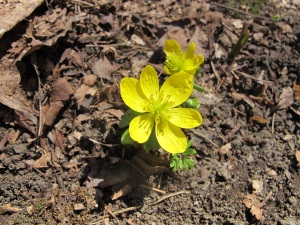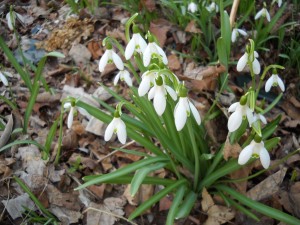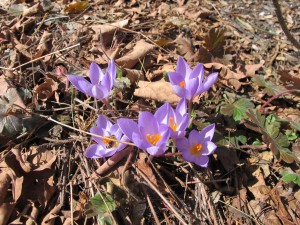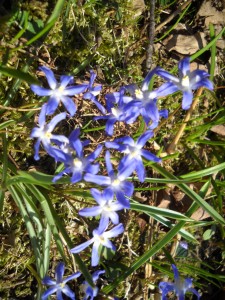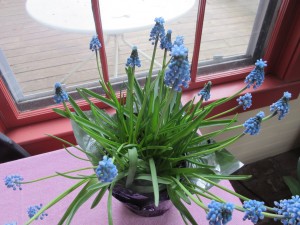Spring Activities
Spring has been slow in showing its colors. Snowdrops, usually up in early March at my house, were a month late. Crocus, the early ones, and winter aconite (a flower that is a nice school bus yellow color) are finally blooming. But everything is slow, and the ground is still frozen a few inches down. I won’t be planting anything outside for weeks.
So what can we do on a warm, sunny day? Maybe we better start by thinking about what NOT to do. Don’t rake the lawn while the soil is still soggy. I recently saw a fellow raking his lawn – even though there was still snow on it in places. Soil structure can be damaged if you compress it and squeeze out all the air spaces in it. This is easily done by walking on it when the soil is still frozen and wet – it’s very fragile. And it’s easy to rip out your grass with a rake if it hasn’t woken up and turned green.
Don’t rototill your vegetable garden early, either. If you are going to rototill, wait until the soil is good and dry. Take a handful of soil and squeeze it into a ball or cylinder. Then, with your other hand, tap it with a finger. It should fall apart. You want the soil crumbly before rototilling, though some clay soils never get to that point. Rototilling sticky wet soil can create heavy clods that roots will not easily penetrate.
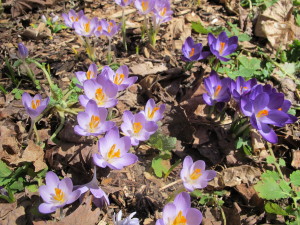
So what can you do now? As soon as the snow disappears you can collect a soil sample and send it off to your state university extension service. Just Google “soil test” and your state, and you will find where to send a sample and how to collect it. I usually sun dry a sample on a cookie sheet, and remove any bits of grass, roots and rocks. As a rule of thumb, it is good to collect your sample from the depth where roots will be. For most things, that is 4 to 6 inches deep.
If you live in a house that was built before 1978, its exterior paint probably has some lead in it. Lead paint has been shown to contaminate soil and to be picked up by plants; this is most severe within 20 feet of the house, or even further if you are on a hill. Testing for heavy metals can be expensive: in New Hampshire the test for it is $65. But if you have small children and will be gardening near the house, it is a worthwhile one-time investment. Children are most severely affected by lead poisoning.
Root crops are the worst offenders when it comes to picking up lead and arsenic, another heavy metal. Lead was an additive to gasoline up until 1996 in most states, and lead from exhaust can still be a problem within 100 feet of a major highway. Arsenic was used as an insecticide, particularly in apple orchards up until the 1980’s, either as lead arsenate or calcium arsenate. Heavy metal compounds like that do not dissipate or disappear easily or quickly.
So how can you improve your soil? In a word, compost. Good compost is biologically active, meaning that it is full of beneficial microorganisms – bacteria and fungi. Later, when my lawn has turned green, I may spread some compost on it to improve the soil. All I do is fling compost over the lawn with a shovel, and then use a lawn rake to even it out.
Half an inch of compost spread out over the lawn will help a lot, particularly if you have used chemicals on the lawn. Fertilizers and particularly “Weed-n-Feed” products inhibit the growth and survival of microbes that will give your lawn that springy feel when you walk on it barefoot this summer. Compost adds organic matter and carbon to feed microbes that can’t use photosynthesis to get their own food. Earthworms love compost, too. Add compost, and they will come and help to get it down into the soil.
I have, carefully, raked leaves off one of my bulb beds. I did so recently. I was delighted to see, beneath a layer of leaves, the tips of daffodils and other bulbs were showing. I didn’t walk into the bed, as that would compact the soil, so I just reached what I could from the edge. That meant the back of the bed stayed unraked for now.
I have been known to lay down boards to walk on to avoid soil compaction at this time of year. Six-inch wide boards cut in five-foot lengths are good: they are light enough to move around, but do a good job of distributing my weight. Two or three is all you need. And once, to avoid compacting the soil, I wore my snowshoes. The neighbors probably thought I was crazy!
This is a good time of year to do a little maintenance on your tools. Take a big, rough file and sharpen the edges of your shovels and hoes. Just try to mimic the angle that exists already. A sharp tool works so much better than a dull one.
I apply boiled linseed oil once a year to keep wooden handles from drying out. I paint it on, let it soak in, and then rub the handles with a rag to polish them up. The handle on my potato hoe, which I got from my family’s garage 30 years ago, is probably 50 years old – but still smooth, strong and splinter-free because I take good care of it.
So don’t rush into spring. Enjoy a warm lazy day from the deck and know that soon the soil will be dry enough to start raking.
Henry Homeyer has a new book: The New Hampshire Gardener’s Companion, Second Edition. This edition has 2 new chapters and updated information in all chapters. His e-mail is henry.homeyer@comcast.net.
The Spring Bulb Flowers
I’ve been paying attention to snowdrops and crocus since I was 9 years old – I recently found entries in my diary that tell me so. My entry for March 7, 1956, in its entirety was this: “Spring is getting here at last the snow drops are in bud + will bloom in a few days.” Then on April 5 I wrote,” Today our first crocus was in bloom it is very pretty.” I still pay attention to them, and generally note when they come into bloom. Now is the time to decide where you should plant bulbs next fall.
Here’s what I do. I wander around my property each year in the spring to see what spots are bare of bulb flowers. I bring along those white plastic markers used for labeling, and write “add crocus here”, for example. Then in the fall, when it’s time to plant more bulbs I don’t have to rely on my memory.
When planting bulbs, I label what I‘ve planted. That way I’ll see what has performed well, and be able to buy more of the same. For example, I’m always eager to get color in the garden at the same time that the snowdrops bloom. Glory –of-the-snow is one plant that overlaps with snowdrops, but is a bit later, as is scilla. This spring I saw that a crocus I planted last fall, ‘Blue Pearl, is blooming with my snowdrops – and before those other two. So I’ll buy 100 of those for fall planting. I bought them at Brent and Becky’s Bulbs– I know because they include tags with each bag of bulbs.
Writing this in early April, I haven’t seen any of my winter aconite appear, though I would have thought they would be up by now. It is a very early bright yellow flower that has one-inch wide, six-petaled flowers. I’ve grown it before but lost it to cold or rodents or poor drainage. I’m still optimistic that it will show up.
I tend to blame bulb failure on drainage problems even though I mix in lots of compost at planting time and favor hillsides. South facing hillsides are great for early bulbs as the snow melts off weeks earlier than north-facing plots. But rodents might be the culprits, too.
A bulb plant that I’ve considered fussy is a low-growing iris, Iris reticulata. It is a lovely iris that blooms near the ground level and has medium-sized blue, purple or (sometimes) yellow flowers. Doing some research I found out why I thought they are fussy: after they bloom, the bulbs divide, producing several little bulblets. These won’t bloom for a few years. So I need to plant some every year until I have a mature colony of them. I also read that they like soil that dries out well in summer, such as in a rock garden or sandy hillside.
My lawn is full of snowdrops that have planted themselves. I assume that they produce seeds that wash into the lawn with early summer rains. The bulk of my snowdrops are planted on a hillside above the lawn. But you can plant early spring bulbs in the lawn, too. Just don’t plant daffodils or anything with large leaves because you won’t be able to mow the lawn where they are growing until the leaves yellow and dry off – around July 4th. Bulb plants need to re-charge their batteries, if you will, by getting sunshine and storing energy.
Little bulbs like snowdrops, crocus and grape hyacinths have short leaves that disappear early and won’t disrupt your early mowing. You can always set the lawn mower blades high to protect the leaves if they are still green when you need to cut the lawn.
Grape hyacinths (Muscari spp.) are great little flowers that come in many different shades of blue and purple. I’ve planted many dozens in my day, but find they tend to lose vigor and disappear with time. So I plant them again. This spring I bought a pot of them at a garden center and have been enjoying them immensely in the house. Later, when the soil is thawed, I’ll plant them outside. I keep the pot in a cool space indoors, as if they get too warm, they flop over.
Tulips I treat like annuals. I plant 100 most years in a bed that I reserve for them – and later zinnias. If I had depended on bulbs planted in 2012 for this year, the number of blooms might be just 50, and maybe 25 the following spring. So I don’t bother to coddle them. In fact, I often pull the flower stem instead of cutting it, as I can get an extra 2-3 inches of stem for my vase, and I love tall tulips. I compost the spent bulbs. I find that adding a few pennies to the water in the vase helps the tulips to last longer before losing their petals, or opening if picked in bud.
Daffodils are slightly poisonous to deer and rodents, so they aren’t eaten – and can bloom for years. You can plant them in open woodlands and they will do fine. I grew up with daffodils planted along paths in our woods, and I still delight in the memory of them. By the way, if you forced paperwhites this winter, don’t bother planting them outdoors – they’re not hardy here.
Bulbs are a great investment. Most come back year after year, bringing me pleasure each year before the garden gets going.
Henry Homeyer is a gardening coach living in Cornish Flat, NH. His Web site is www.Gardening-Guy.com.



